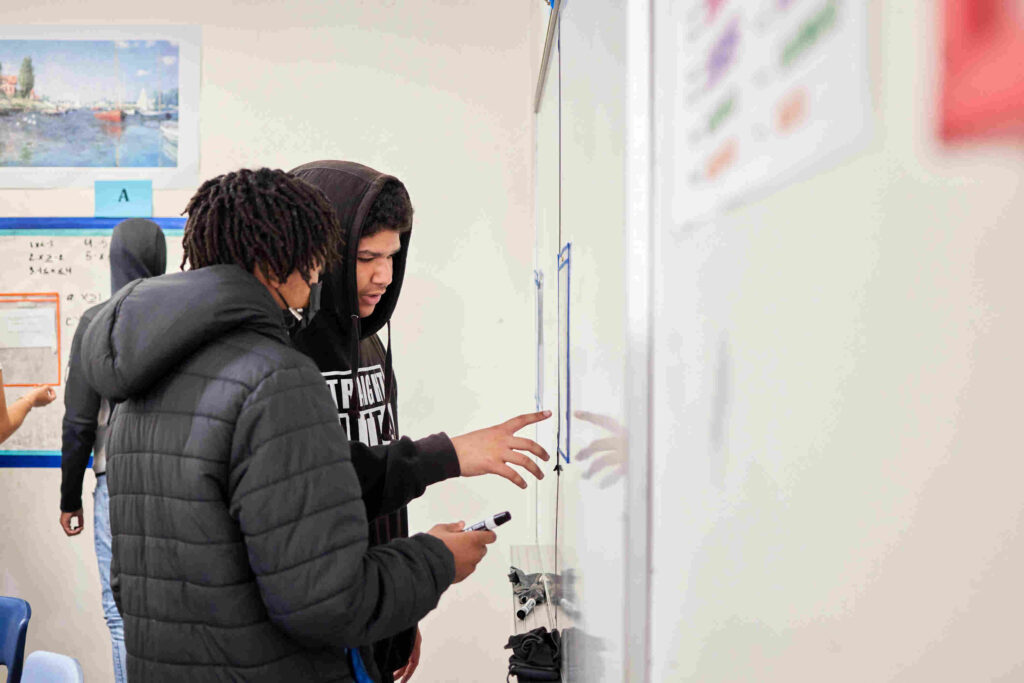November 2024

After nearly four years of thoughtful development and several revisions, the new Mathematics Framework for California Public Schools was officially adopted in July 2023. While the 2013 framework introduced the Common Core Content Standards for Mathematics, this updated version goes even further. It provides math educators with proven, research-based strategies to enhance their teaching and ensure access and inclusion for all students. The CPM California Team thought it would be helpful to highlight key components of the new framework, which we believe describes what engaging math classes look like—the kinds of classes we see when using CPM curriculum.
What is in the new framework?
The new framework aims to assist educators and curriculum writers with their instructional planning and delivery as they prepare students to explore major conceptual ideas in mathematics. The new framework outlines three essential components of preparing to teach mathematics: Drivers of Investigation, Standards for Mathematical Practice, and Content Connections. Together, these components focus on fostering curiosity, promoting excellence in math learning, and ensuring equitable access for all California students.
Drivers of Investigation
A key factor in getting students interested in mathematics is piquing their curiosity and helping them see connections to the world around them. CPM has relied on its core learning pillars to guide us in this endeavor by having a foundation in Problem-Based Learning. By utilizing tasks that cannot be solved with simple algorithms, students realize their path to success lies in working with their peers. In addition to engaging contextual problems, CPM includes lesson Launches designed to create student intrigue and wonder about the investigation. Each Launch in an Inspiring Connections lesson (also coming to Core Connections 3rd edition) is carefully crafted and chosen to engage students with major conceptual ideas. Inspiring Connections Launches include Data Chats, which drive curiosity about current world events, and a variety of other Math Chats designed to prioritize student discussion and critical reasoning skills.
As described in the framework, the Drivers of Instruction (DIs) are comprised of three main frames for teachers to utilize, all intending to address the “Why?” of an investigation: Make sense of the world (DI 1), predict what could happen (DI 2), and see the impact on the future (DI 3). The DIs provide three different perspectives in which students can interact with the major conceptual idea of an investigation, which leads to them making connections to the larger world and maintaining interest throughout a lesson or a unit, or even across years.
Standards for Mathematical Practice
The Standards for Mathematical Practice (SMPs) are familiar to mathematics educators, especially those using CPM. The purpose of the SMPs is to embed the habits of mind and interactions that form the basis of learning mathematics. Together, these eight SMPs address the “How?” of an investigation and are designed to support students’ development throughout their math educational experience. Unlike content standards, the SMPs are the same at all grade levels, providing students ample time and opportunities to hone these skills.
CPM’s Collaborative Learning pillar provides a natural entry point for educators to embed the SMPs into their investigation. When students work on team-worthy problems, they can use the practices authentically and encourage collaboration with their peers. Included in the Teacher Notes of each lesson, the SMPs are a highlight in every CPM curriculum offering. Each lesson contains one to two SMPs that are the lesson’s focus and that guide teachers as they support students in their mathematical practice. Supporting students through the use of routines, Study Team & Teaching Strategies, and purposeful questioning helps them utilize the SMPS as a means to learn mathematics at a deeper level and provides tools for them to lean on when approaching more complex concepts.
Content Connections
CPM has always strived to organize curriculum content in a way that naturally flows and progresses the mathematical storyline while providing multiple opportunities for teachers to support mathematical coherence. Our third pillar, Mixed, Spaced Practice, has served as a guide and provided us with a foundation on which we can support student learning. By organizing the content in a way that allows students to revisit problems over a longer period of time, we often hear of students seeing increased achievement, better long-term retention, and improved transferability of skills between conceptual and procedural tasks.
The Content Connections (CCs) of the CA Framework are designed for the “What?” of an investigation. When combined with the DIs and SMPs, the CCs can support the development of the skills and dispositions expected of California high school graduates. The expectation is that the CCs are developed through questions in authentic contexts, allowing students to reason with data (CC 1), explore changing quantities (CC 2), take wholes apart and put parts together (CC 3), and discover shape and space (CC 4).
Five Components of Equitable and Engaging Teaching
Our classrooms are filled with students from diverse backgrounds with differing mathematical experiences and learning needs. CPM has always endeavored to write a curriculum to meet these needs and create More Math for More People. Included in the CA Framework are the Five Components of Equitable and Engaging Teaching, designed to help educators expand their inclusive teaching practices.
Plan Teaching Around Big Ideas
The first component is to plan teaching around the big ideas, also referred to as the major conceptual ideas. When teachers plan with the major conceptual ideas as the centerpiece, they can better build on ideas that arise from students during instruction, draw out student understanding, and allow students to see the connections to the larger mathematical picture.
CPM’s curriculum has always prioritized helping students see the big picture of mathematics. One way is through our storylines and threads that weave horizontally within each course and vertically through multiple courses. As students progress through the courses, they begin to see how the amazing story of math unfolds as the major conceptual ideas are unveiled.
Use Open, Engaging Tasks
As educators who attend CPM professional learning know, when tasks are closed, teachers typically ask narrow questions that don’t provide appropriate cognitive challenges for students. On the other hand, using open and engaging tasks allows students to be appropriately challenged within the grade level and relies on its core learning pillars to guide us in this endeavor by providing a foundation in problem-based learning content, creating “low floor, high ceiling” opportunities for students of all mathematical abilities.
Teach Toward Social Justice
The third component of equitable and engaging teaching is teaching toward social justice. When we empower students in mathematics competency, they are better equipped to examine inequities and address issues in their lives and communities. Teaching toward social justice also plays a role in identity development. Teachers have the opportunity to play a vital role in helping students shape their sense of self, doing so in culturally responsive and relevant ways.
Invite Student Questions & Conjectures
Teachers of CPM know that as they implement open, engaging tasks and center instruction around the major conceptual ideas, there is a natural opening for students to question and develop conjectures about mathematics. Such questions should be valued, and students should be given time to explore their inquiries. Teachers should encourage questions, promote a classroom culture of developing conjectures, and support creative thinking to determine answers.
Prioritize Reasoning & Justification
The last component of Equitable and Engaging Teaching in the CA Math Framework is prioritizing reasoning and justification. In addition to honing students’ mathematics skills and thought processes, prioritizing reasoning and justification also builds their communication skills.This challenges students to think flexibly, solidify their thinking as they communicate with others, and actively participate in their own learning.
How will instruction change under the framework?
A question you might have at this point is, “How will my day-to-day instruction change due to this new framework?” As curriculum developers analyze and consider the CA Framework, it is their job to determine how they implement the Drivers of Investigation, Standards for Mathematical Practice, and Content Connections, as well as the components of Equitable and Engaging Teaching. If you are not currently utilizing CPM as your mathematics curriculum, communicate with those on your leadership team to ensure your curriculum is aligned with the CA Framework.
If you are currently using CPM, you are in great shape! Our newest middle school curriculum, Inspiring Connections, aligns with the CA Math Framework and is a multimodal curriculum that includes a new digital platform. Inspiring Connections also offers a fresh update to our strategies and resources, as well as incorporating different learning venues, such as vertical non-permanent surfaces and a consumable Mathematician’s Notebook, that will help maximize student engagement. Learn more about Inspiring Connections.
CPM is also updating our Core Connections series to the 3rd Edition, which will incorporate new research and offer a fresh take on familiar lessons. The foundational design of Core Connections 3rd Edition will continue to be students working collaboratively on engaging, contextual problems, with many tested and loved lessons from earlier editions. New in this edition, each lesson will include a dedicated Launch. Reflection Journal prompts for students to reflect on their learning and incorporate social-emotional learning components throughout the materials. Data Science is also woven throughout the curriculum so that students can experience how to analyze and make sense of what data is telling them. While the 3rd Edition is still being finalized, keep an eye out for middle school materials to be released in Spring 2025. Read about updates and additions to Core Connections 3rd Edition.
CPM always strives to implement research-based best practices that foster inclusive environments for all students. With CPM’s Three Pillars as a foundation, constantly updated Professional Learning opportunities, and new course offerings, CPM has accomplished these goals and more. As the new CA Framework begins to roll out and programs update their curricula, rest assured that CPM has been meeting these framework objectives for years. While incremental and minor changes will be made, CPM will continue to innovate with research-based best practices that support student learning and educator professional development.
(If you currently use CPM and are looking for more support with the Framework, check out the on-demand module in CPM’s Professional Learning Portal.)
The Mathematics Framework for California Public Schools: Kindergarten Through Grade Twelve (Mathematics Framework) was officially adopted by the State Board of Education (SBE) on July 12, 2023. Read more about the framework on the California Department of Education website.

